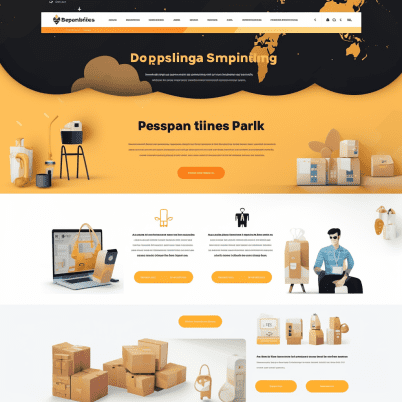As the digital clock ticked over to mark the start of 2023, entrepreneurs around the world found themselves asking a question they never thought they’d utter: Is dropshipping dead? This model, once touted as the golden child of e-commerce, now sits on the chopping block of debate, drawing much speculation about its viability. Welcome to our deep dive into the evolution of dropshipping.
In this hyper-connected, convenience-fueled era, is gasping its last breaths or is it still a vibrant, viable strategy for aspiring and established entrepreneurs alike? Have the numerous shifts and tumults of the e-commerce landscape finally snuffed out dropshipping’s flame, or has this adaptable business model simply undergone an evolution?
For years, dropshipping has been the cornerstone of e-commerce start-ups worldwide, allowing businesses to offer a wide range of products without maintaining an expensive inventory. But as the digital world evolves at a lightning pace, it’s only logical to wonder whether dropshipping is keeping up or becoming a relic of the past.
Join us as we navigate through the corridors of change, sifting through the rubble of rumor and speculation, and mining the gold of hard facts. We’ll examine the past, present, and potential future of dropshipping, providing you with valuable insights to help shape your 2023 e-commerce strategy. Is a sinking ship or a submarine ready to resurface stronger than ever? Let’s find out together.

What is dropshipping?
Dropshipping is a supply chain management method where a store doesn’t keep the products it sells in stock. Instead, when a store sells a product, it purchases the item from a third party and has it shipped directly to the customer. As a result, the merchant never sees or handles the product.
This contrasts with standard retail models, where the store purchases inventory from a supplier and then sells that inventory to customers.
Here are a few key characteristics of the dropshipping model:
-
Low Capital Requirement:
Because you don’t need to purchase inventory upfront, the initial investment can be much lower compared to traditional retail businesses.
-
Easy to Get Started:
You don’t need a physical storefront or even storage for your products. Most of the logistics are handled by the supplier.
-
Wide Product Selection:
Because you don’t have to pre-purchase the items you sell, you can offer an array of products to your customers.
-
Flexible Location:
As long as you can communicate with suppliers and customers, you can run a dropshipping business from anywhere with an internet connection.
However, there are also some challenges associated with dropshipping:
1. Low Margins:
Because it’s easy to start a dropshipping business, it can be a highly competitive space. Many dropshippers sell products at near-cost prices in an effort to grow their customer base, which can make it difficult for a business to earn a significant profit.
2. Inventory Issues:
If your supplier runs out of a product, you may find yourself unable to fulfill orders until the product is back in stock.
3. Shipping Complexities:
If you work with multiple suppliers—as many dropshippers do—products on the same order could be sourced and shipped separately.
4. Limited Branding and Customization:
As the seller, you typically have less control over how the product is packaged and presented, which may limit your ability to promote your brand
5. Quality Control:
Since the retailer never sees the product, they have less control over the product quality, can lead to customer dissatisfaction or potential reputational damage.
Despite these potential challenges, many entrepreneurs have found success using a dropshipping business model, especially those who invest in a high-quality website, customer service, and marketing.
Is Dropshipping Still Alive: A Look at Google Trends for Dropshipping
The advent of the internet brought a myriad of opportunities in the realm of business, and one such opportunity is dropshipping. As a low-risk business model, it has enticed countless entrepreneurs worldwide, effectively creating a revolution in the retail landscape.
However, as with any business model, the question arises — Is dropshipping still alive? Is it still a profitable venture in 2023? In this analysis, we turn to Google Trends, an invaluable tool that analyzes the popularity of top search queries in Google Search.
Understanding Google Trends
Before we delve into the data, it’s crucial to comprehend what Google Trends is. It’s a service provided by Google that shows how often a particular search term is entered relative to the total search volume across various regions of the world, and in various languages.
The tool uses graphs to compare the search volume of different queries over time. This tool is a window into the collective consciousness of internet users and can provide invaluable insights into trends and fads.
Analyzing Dropshipping Trends
When looking at the Google Trends data for the search term “dropshipping,” we see some notable patterns. The term’s popularity over time, measured by search volume, has experienced highs and lows.
For instance, during the peak of the COVID-19 pandemic in 2020, there was a significant surge in interest in as traditional brick-and-mortar retail faced unprecedented challenges. This trend attests to dropshipping’s viability during times of crisis, providing entrepreneurs a resilient business model.
However, the post-pandemic years, 2022 and onwards, saw a gradual decline in searches for “dropshipping.” This decrease could be attributed to various factors such as the return to traditional shopping habits or increased competition in the sphere.
Still, it’s essential to note that a decline in search volume does not necessarily signify a decrease in the viability or profitability of dropshipping. Despite a dip in Google Trends, the interest in dropshipping remains considerably consistent, indicating a continued relevance and a robust user base.

-
Search Trends by Region
Analyzing the interest by region provides an insightful perspective. Certain regions have consistently high search volumes for “dropshipping,” such as Southeast Asia, parts of Europe, and North America. These regions are known for their strong e-commerce sectors, which likely contribute to the sustained interest in this category. It shows that in these regions, dropshipping is still very much alive and thriving.
-
Is Dropshipping Worth It? A Comprehensive Review
Dropshipping is a popular business model that allows entrepreneurs to start an online store and sell products to their customers without ever actually stocking the items themselves. It is a model that eliminates the need for inventory, warehouses, and significant upfront costs. However, does this mean that dropshipping is worth it? Here’s a comprehensive review.
-
Low Start-up Costs
Dropshipping has a low barrier to entry, making it an accessible option for entrepreneurs who do not have a lot of capital to start with. There’s no need to invest heavily in initial inventory, nor is there a need for physical business premises. You simply set up your online store, find suppliers, and start selling. This lowers the financial risk and makes dropshipping a potentially attractive prospect.
-
Easy to Scale
As a dropshipping business owner, you don’t have to worry about the logistical challenges of scaling up, such as storage space for more products or extra shipping responsibilities. If your business grows and you start selling more, it’s your suppliers that will need to meet the increased demand. This makes dropshipping a business that’s easier to scale than most.
However, the ease of scaling up is a double-edged sword. It can lead to complacency and a lack of control, which can be a recipe for disaster if your suppliers can’t keep up with the demand or fail to maintain quality.
-
Supplier Dependence
A significant downside to dropshipping is the dependence on suppliers. If your suppliers are unreliable, it can lead to delayed or missing orders, sub-par products, and poor customer service — all of which will reflect badly on your business. Building strong, reliable relationships with suppliers is crucial but can also be challenging, particularly when dealing with overseas suppliers.
-
Low Margins
The ease of starting a business leads to high competition, which can drive down profit margins. Many dropshipping products are available from numerous suppliers, so businesses often compete primarily on price, especially in popular niches. This means that unless you can find a unique product or create a strong brand that adds value, you may find your profit margins are lower than you’d like.
-
Customer Service Challenges
With dropshipping, you’ll have less control over how and when your products are delivered. This can lead to customer service challenges, such as dealing with complaints about products that arrive late or damaged. While these issues are out of your control, you’ll be the one who has to manage customer expectations and resolve any issues.
Is Dropshipping Dead in 2023? An Examination of the Business Model
Dropshipping, a retail fulfillment method where a store doesn’t keep the products it sells in stock, has long been a popular business model. It’s a low-risk, low-investment way to start an online business, making it an attractive proposition for many entrepreneurs. However, with the rapid evolution of e-commerce and a seemingly oversaturated market, the question has arisen: Is dropshipping dead in 2023?
- Market Saturation and Competition
One of the main arguments made by those who believe that is dead is the idea of market saturation. With the ease of starting a dropshipping business, there has been a surge of new businesses all vying for a piece of the pie.
This increased competition, coupled with consumers’ growing awareness of dropshipping tactics, such as higher prices for readily available items, has made it more challenging to find success with this model.
However, saturation doesn’t necessarily mean the death of a business model. Rather, it signals a shift in the landscape. In this new climate, dropshippers will need to focus more on adding value through unique product selection, excellent customer service, and effective branding to differentiate themselves from the competition.
- Evolution of Consumer Expectations
Consumers in 2023 are savvy, and their expectations are higher than ever before. They demand fast shipping, high-quality products, and excellent customer service.
While these demands present challenges to the dropshipping model, especially with delivery times often being longer and control over quality lower, they don’t spell the end for dropshipping.
Instead, they highlight the need for dropshippers to be selective in choosing suppliers, focusing on those who offer quality products and reliable shipping times. There is also a greater need to provide stellar customer service to build trust and foster customer loyalty.
-
Role of Technology
Technological advancements also play a critical role in determining the viability of dropshipping in 2023. With the rise of automation and sophisticated e-commerce platforms, managing a dropshipping business has become more streamlined and efficient.
Furthermore, technology has enabled better communication with suppliers, enhancing the ability to ensure quality and timeliness, which are crucial in meeting evolving consumer expectations.
Additionally, the emergence of AI and data analytics allows businesses to understand consumer behavior better, predict trends, and personalize the shopping experience. These advancements can be leveraged to maintain a competitive edge in the dropshipping arena.
Why Are Some Dropshipping Stores Thriving? A Deep Dive into Successful Strategies
Dropshipping is a business model that continues to generate substantial interest, despite the considerable challenges it presents. Despite the tough competition and ever-evolving e-commerce landscape, certain dropshipping stores continue to thrive. The question then is, what are these successful stores doing differently? Let’s explore the key factors behind their success.
-
Finding a Niche
One common characteristic of thriving dropshipping stores is their focus on a specific niche. By targeting a narrow market segment with specific interests or needs, these businesses effectively reduce their competition and can position themselves as specialists. This focus allows them to tailor their offerings and marketing strategies to a specific audience, resulting in a more engaged and loyal customer base.
-
Quality Over Quantity
Successful dropshipping stores understand the importance of quality, both in terms of products and suppliers. They are meticulous about sourcing high-quality products from reliable suppliers, ensuring customer satisfaction and repeat business.
These stores understand that the longevity of their business hinges on customer satisfaction, which is intrinsically linked to the quality of the products they sell.
-
Investing in Customer Service
Thriving dropshipping stores also invest heavily in customer service. They understand that in the world of e-commerce, positive customer experiences can significantly impact their business’s reputation and growth. Therefore, they make it a priority to resolve customer issues promptly and effectively, foster good relationships, and build trust with their customer base.
-
Branding and Marketing
Effective branding and marketing are key contributors to the success of these stores. They invest time and effort in building a recognizable brand and crafting compelling narratives around their products. They utilize various digital marketing strategies, such as social media marketing, email marketing, and content marketing, to reach their target audience and generate interest in their products.
-
Leveraging Technology
Successful dropshipping stores also leverage technology to streamline their operations and improve their customers’ shopping experience. This includes using e-commerce platforms to manage their online stores, automation tools to optimize their workflows, and analytics tools to track their performance and make data-driven decisions.
-
Innovation and Adaptability
The world of e-commerce is fast-paced and constantly changing. As such, thriving dropshipping stores exhibit a high level of innovation and adaptability. They stay up-to-date with market trends, adapt their strategies accordingly, and are always on the lookout for new products and opportunities to grow their business.
Dropshipping vs. Affiliate Marketing: Which One Is More Profitable?
Dropshipping and affiliate marketing are two popular online business models that have drawn in entrepreneurs worldwide due to their relatively low start-up costs and potential for substantial profits. Both models offer unique advantages and drawbacks. So, which one is more profitable? Let’s dive into the details.
-
Understanding Dropshipping
In dropshipping, you create an online store and sell products. When customers make a purchase, you forward the order to a third-party supplier, who then ships the product directly to the customer. The profit comes from the difference between what the customer pays you and what you pay the supplier.
Advantages of Dropshipping:
1. Control over Pricing:
You set your own prices and can adjust them based on market conditions or customer demand, allowing for more potential profit per sale.
2. Brand Building:
You have the opportunity to build your brand, which can increase customer loyalty and repeat business.
Disadvantages of Dropshipping:
-
Managing Customer Service:
You’re responsible for handling customer complaints and returns, which can be challenging when you don’t control the product’s quality or shipping.
2. Lower Margins:
Due to intense competition, profit margins in dropshipping can be low, especially if you’re selling common products.
Understanding Affiliate Marketing
In affiliate marketing, you promote other companies’ products and earn a commission for every sale made through your referral link. You don’t handle products, shipping, or customer service – your sole focus is on marketing and driving traffic to your affiliate links.
Advantages of Affiliate Marketing:
1. Low Risk:
You don’t need to worry about unsold inventory, managing suppliers, or handling customer service. Your main investment is your time and marketing effort.
2. Broad Product Selection:
You can promote a wide variety of products from multiple merchants, giving you more opportunities to earn commission.
Disadvantages of Affiliate Marketing:
-
No Control over Pricing:
Commissions are set by the product owner, so your earnings per sale are fixed.
-
Dependence on Merchant:
- If the merchant discontinues the product or ends their affiliate program, it could negatively impact your income.
Dropshipping vs. Affiliate Marketing: Which is More Profitable?
Both dropshipping and affiliate marketing can be profitable, but the potential earnings can vary greatly based on many factors, including your niche, marketing skills, the products you sell or promote, and the relationships you have with suppliers or merchants.
Dropshipping can potentially yield higher profits per sale because you set your prices. However, the costs of running a dropshipping store, including marketing, platform fees, and potentially handling returns, can eat into your profits.
Affiliate marketing might offer a lower profit per sale, but the lower operating costs can make it an attractive option. Your main focus will be creating high-quality promotional content and driving traffic to your affiliate links.
Alibaba Dropshipping: Is It Still Worth It?
Alibaba is a well-known marketplace based in China that connects buyers from around the world with manufacturers and wholesalers. It’s a platform that has long been used by dropshippers to source a wide range of products at relatively low costs. But with the ever-changing landscape of e-commerce and a myriad of options available, the question arises: Is Alibaba dropshipping still worth it in 2023?
Pros of Alibaba Dropshipping
-
Vast Product Selection:
Alibaba hosts a wide range of manufacturers offering a massive variety of products. This extensive selection can be a boon for dropshippers seeking to diversify their product offerings or find unique products to set their store apart.
-
Competitive Prices:
With direct access to manufacturers and wholesalers, Alibaba can often offer lower prices than other sources, which can potentially result in higher profit margins for dropshippers.
3. Customization Options: Many Alibaba suppliers offer customization options, enabling dropshippers to tailor products to their specifications or even create their own branded items.
Cons of Alibaba Dropshipping
1. Quality Control:
Since you’re not able to inspect the products yourself, there’s a risk of sub-par quality or products that don’t match the provided descriptions. This can lead to customer dissatisfaction and damage to your brand’s reputation.
2. Communication Challenges:
Given that most Alibaba suppliers are based in China, language barriers can sometimes pose communication challenges. Time zone differences can also result in delays in responses.
3. Shipping Times:
Shipping times from China can be long, which can lead to frustrated customers. While some suppliers offer faster shipping options, these often come at a higher cost, which could cut into your profits.
Is Alibaba Dropshipping Still Worth It?
The answer to whether Alibaba dropshipping is still worth it largely depends on the individual business. Despite the challenges, Alibaba can still be a worthwhile platform for dropshippers who are willing to put in the time and effort to find reliable suppliers and manage the potential pitfalls.
Doing thorough research on suppliers, including checking reviews and ratings, asking for product samples, and maintaining clear communication can help mitigate some of the risks associated with Alibaba dropshipping. Furthermore, finding unique products or taking advantage of customization options can help a dropshipping business stand out from the competition and increase profitability.
What Are the Biggest Problems That Dropshippers Face in 2023?
The world of dropshipping has evolved significantly over the past few years, and 2023 brings its own set of unique challenges. The dropshipping model allows entrepreneurs to start an online business and sell products to their customers without ever actually stocking the items themselves. However, several significant issues can make this business model particularly challenging. Here are some of the biggest problems that dropshippers face in 2023:
1. Supply Chain Issues:
The ongoing effects of the COVID-19 pandemic and subsequent geopolitical events have led to major disruptions in global supply chains. These disruptions mean increased costs, delays, and uncertainties for dropshippers who rely on a smooth and efficient supply chain.
2. Shipping Delays:
Alongside general supply chain disruptions, international shipping has seen its fair share of issues. Stricter customs regulations, increased shipping costs, and longer delivery times have all become notable challenges for dropshippers in 2023.
3. Increased Competition:
The barriers to entry in dropshipping are quite low, which has led to a surge in competition. More people than ever are turning to e-commerce, leading to market saturation in some niches. Differentiating your brand and products has become even more crucial and challenging.
4. Customer Expectations:
Online shoppers in 2023 have high expectations for quick and reliable delivery. Unfortunately, with the inherent delay of the dropshipping model and the added issues of supply chain disruptions, meeting these expectations can be difficult.
1. Sustainability Concerns:
The environmental impact of dropshipping is becoming increasingly scrutinized. Consumers are more conscious of their purchases’ ecological footprint, and many are opting for brands with strong sustainability practices. Addressing these concerns within the dropshipping model can be challenging.
2. Regulations and Compliance:
New data protection regulations and tax laws have come into effect in several regions, requiring businesses to comply or face heavy penalties. For dropshippers who deal with international customers, keeping up with the regulatory landscape is crucial yet daunting.
1. Quality Control:
As dropshippers don’t handle their products, they’re often reliant on their suppliers for quality control. However, inconsistencies can arise, which can lead to customer dissatisfaction and potential harm to the business’s reputation.
2. Vendor Reliability:
Establishing a reliable relationship with suppliers is key in dropshipping. However, some dropshippers encounter issues with suppliers, such as poor communication, inconsistent stock levels, and low product quality.
3. Marketing Costs:
With the increase in competition, the costs of marketing and customer acquisition have risen. Social media ads, email marketing, and other digital marketing methods have become more expensive, which can eat into the profits of dropshippers.
4. Technology Adaptation:
The e-commerce landscape is fast-paced and ever-changing. New technologies and platforms constantly emerge, and failing to adapt to these changes can leave dropshippers behind.
What is the dropshipping success rate?
The dropshipping success rate can vary significantly depending on several factors, including the specific niche, the quality of products, marketing strategies, and the level of commitment and effort put into the business. While there is no definitive success rate for dropshipping, it is important to understand both the potential advantages and challenges involved.
One advantage of dropshipping is the relatively low startup costs and the ability to test different products and markets with minimal financial risk. Additionally, dropshipping allows for flexibility as it does not require inventory management or fulfillment logistics.
However, dropshipping also presents certain challenges. Since the barrier to entry is low, the market can be highly competitive, making it crucial to differentiate your business and offer unique value to customers. Another challenge is the dependence on suppliers and their ability to deliver products promptly and maintain consistent quality.
Due to the variability in success rates, it is difficult to provide an exact figure. Success in dropshipping often relies on factors such as effective marketing, identifying profitable niches, building a strong brand, providing excellent customer service, and adapting to market trends. By focusing on these areas and continuously learning and improving, entrepreneurs can increase their chances of achieving success in the dropshipping business.
Why People Fail With Dropshipping
While dropshipping can be a lucrative business model, there are several reasons why people may fail with it. Here are some common factors that contribute to dropshipping failures:
1. Poor product selection:
One of the key aspects of dropshipping success is offering products that have a demand in the market. Choosing products without proper market research or selecting oversaturated niches can lead to limited customer interest and low sales.
2. Ineffective marketing and branding:
Dropshipping requires effective marketing strategies to attract potential customers. Failing to create a strong brand identity, target the right audience, or execute marketing campaigns can result in low visibility, limited traffic, and poor conversion rates.
3. Lack of customer trust:
Building trust with customers is crucial for any business, including dropshipping. If customers experience issues such as delayed shipping, poor product quality, or inadequate customer service, it can lead to negative reviews and damage the reputation of the business.
4. Insufficient customer service:
Providing excellent customer service is essential in any business. Failing to address customer inquiries, concerns, or complaints promptly and professionally can lead to dissatisfied customers and negative word-of-mouth.
5. Inventory and supplier issues:
Reliance on suppliers for product sourcing and order fulfillment can lead to challenges. Problems like stockouts, shipping delays, or low-quality products can impact customer satisfaction and the overall success of the dropshipping business.
6. Lack of differentiation:
With the low barrier to entry in dropshipping, competition can be fierce. Failing to differentiate your business, offer unique products, or provide additional value compared to competitors can result in being overshadowed and struggling to attract customers.
7. Unrealistic expectations and lack of commitment:
Some people enter with unrealistic expectations of overnight success or minimal effort. Like any business, dropshipping requires time, effort, and dedication to succeed. Those who give up too quickly or are not fully committed may struggle to see positive results.
Is Dropshipping Worth It In 2023?
Dropshipping has been a popular business model for several years, and it’s worth in 2023 continues to be a topic of interest for aspiring entrepreneurs. While the landscape of dropshipping may have evolved, there are still factors to consider when determining if it’s worth pursuing in 2023:
1. Market saturation:
Dropshipping has become increasingly competitive over the years, with more entrepreneurs entering the market. This means that finding profitable niches and standing out from the competition can be more challenging. Thorough market research is crucial to identify untapped or underserved markets and capitalize on emerging trends.
2. Evolving consumer behavior:
Consumer behavior and preferences are constantly changing, influenced by factors such as technology advancements, social media, and global events. Keeping up with these changes and adapting marketing strategies to align with consumer preferences is vital for success in dropshipping.
3. Supply chain challenges:
Dropshipping relies on suppliers for product sourcing and order fulfillment. In recent years, disruptions in global supply chains due to factors like the COVID-19 pandemic have affected product availability, shipping times, and costs. It is important to establish relationships with reliable suppliers and stay informed about any potential challenges or disruptions.
4. Brand building and customer trust:
Building a strong brand and establishing trust with customers are critical for long-term success in dropshipping. In a crowded market, investing in branding efforts, providing exceptional customer service, and delivering high-quality products are essential to differentiate your business and foster customer loyalty.
5. Profit margins and scalability:
While dropshipping offers the advantage of low upfront costs, it’s important to carefully consider profit margins. With competition and potential overhead costs, such as marketing expenses and transaction fees, ensuring profitability can be a challenge. Additionally, scalability may be limited by factors such as supplier capabilities or inventory management.
5. Alternative business models:
As dropshipping has become more mainstream, alternative business models have emerged, such as print-on-demand and private labeling. These models offer greater control over product quality, branding, and customer experience but may require more upfront investment.
Ultimately, whether is worth it in 2023 depends on various factors, including your ability to navigate the challenges, adapt to changing market dynamics, and differentiate your business effectively. Success requires a strategic approach, commitment to continuous learning, and a willingness to adapt to market trends. By carefully considering the pros and cons, conducting thorough market research, and implementing effective strategies, entrepreneurs can still find opportunities and achieve success in dropshipping in 2023.
If you want to get best quality dropshipping service then Contact Us .





